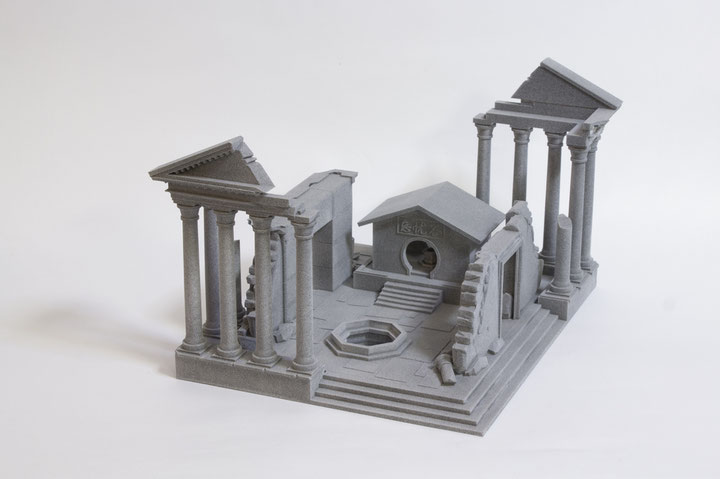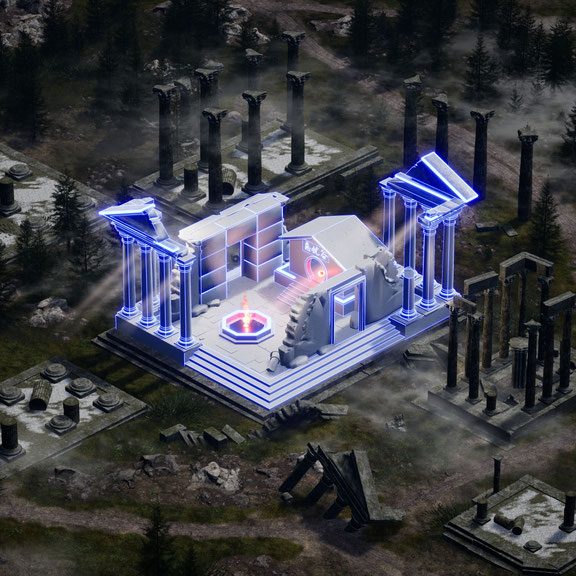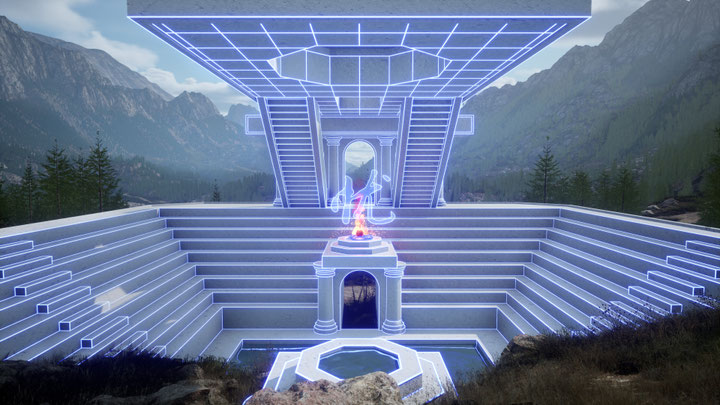Issue 3/2022 - Net section
Regeneration in Virtual Space
On Lawrence Lek's Multimedia Work "Nepenthe Valley"
The media artist, filmmaker, and musician Lawrence Lek (born 1982 in Frankfurt) creates films and animations that explore the future of our civilization by using video game software. He uses socio-economic and political developments and their potential impact on our future life as a point of departure in his works. During his time studying architecture in Cambridge and New York Lek learnt 3D software modelling and how this could be used to build virtual worlds, today, an essential part of his artistic production. In conversation with the artist, Lek talks about his latest work, “Nepenthe Valley”.
He uses NFTs as the first stage of its multi-segmented presentation and the work brings real value to the subject of healing and regeneration, which in the form of spells and healing potions are a fundamental component of many video games. In this way he aims to facilitate the experience of mental health and meditation in a virtual world. As technologies advance, so does the framework within which his art operates. Due to the growing understanding of video games and interactive media art by users, the demand for the medium is increasing. As we spend most of our time in virtual spaces and due to the sheer mass of digital entertainment available, the breakthrough to completely new audiences hardly seems possible. Nevertheless, Lek manages to take elevate the function of digital spaces with the help of improved virtual simulations.
A first version of “Nepenthe Valley” was shown at Art Dubai in March 2022. The work focuses on relaxation and reflection in the digital space. Drawing inspiration from landscape painting, fantasy and sci-fi aesthetics, Lek creates both futuristic and ancient ruins that serve no practical or ceremonial purpose other than to be contemplated in a lush green landscape. While the current stage of the work exists as a series of NFTs and still images, it could be developed as a video game at a later stage. Visitors can experience a form of relaxation and healing through contemplative interaction with the nature and architecture of the fictional world. “Video game mechanics are based on life, health and regeneration. These universal themes, as well as aspects such as mental health or psychological condition, are reflected in video game worlds. In the first phase of Nepenthe Valley, I wanted to address these issues in a condensed form,” says Lek.
Down the valley along a river, viewers find places such as a spring or a shrine. The idea of the romantic Central European hiker or conquering mountaintops is subversively inverted and reinterpreted as a deliberate descent; an affinity rather than dominance over nature. The title of the work is taken from the name of a medicine in ancient Greek mythology, which makes the consumer forget worries and suffering. Inspired by the idea of regeneration in video games, “Nepenthe Valley” intends to represent a real form of healing that is created through a game or a virtual world, but whose effects can also be experienced in “real” life.
Recreation in nature and the rediscovery of our surroundings are as relevant today as they were during the first wave of the romantic idea of the wanderer who loses himself in nature and thereby escapes the increasingly industrial and urban society of the 19th century. However, hidden in this painterly-meditative sphere is another theme that Lek deals with in various aspects of the work. According to Lek “the domination of nature through technology goes hand in hand with a desire to lose oneself in nature.” He contrasts this longing with exploring the globe and colonizing non-European countries. Scattered across the landscape are ruins that suggest an ancient society or rich history of this fictional world. “Fictitious stories are often hidden in fantasy games, as they have appeared in our media in recent years,” says Lek. Alluding to fictional stories, these ruins also suggest fictional messages and manipulated information in digital spaces. What is presented and perceived as fact on the internet can turn out to be fictitious on closer inspection.
In connection with the soundtrack of the work, which is also reminiscent of RPG games (Role Playing Games) and fantasy films paired with meditative sounds, “Nepenthe Valley” offer a variety of perspectives and possibilities of interpretation that go far beyond the two-dimensionality and superficiality of popular versions of this new medium and thus claims its own category as “high-art” NFTs.
Lek sees the digital distribution of his work as an opportunity for the democratic reception of his art. Regarding the control that the artist gains over the players, Lek talks about digital art as a medium accessible to a wide audience. The understanding of the digital space as a familiar place corresponds to a reinterpretation of Marc Augé's so-called “non-places”. These are spaces without enough significance to be understood as actual places in the anthropological sense. Rather, people can navigate these spaces anonymously. Such an understanding has developed over the past decade, especially among younger audiences, which makes it possible for intimate topics such as regeneration and healing to be negotiated in virtual space.
With the digital distribution of his works, Lek also sees a shift away from controlling a smaller audience to addressing a larger audience. While works like “Notel”, presented at Art Basel in 2019, have been strongly defined by the authority of the artist, the gallery, and the fair, experiencing and interacting with digital works outside of the physical exhibition space is not immediately predetermined. Lek's work only unfolds in the collaborative process of the participating platforms including the audience, the owners of the NFTs as well as the curators, connecting the distribution and the construction of the work. As part of the creation process, Lek aims to further engage with the audience's expectations and speculation as to which possible forms the work may take.
Our understanding of digital art and video games as art is now broader and more nuanced than it was even five years ago. This is fueled by the accessibility of NFTs which allows Lawrence Lek to progress towards a more liberated form of storytelling and world building which he developed through his artistic production over the last decade. “Nepenthe Valley”, with its multi-stage development cannot only be seen as a step towards new forms of distribution. Rather, the work conveys a subtle and delicate free feeling, away from a conducting and towards a playful position of the artist.
https://horizons.space/gallery


